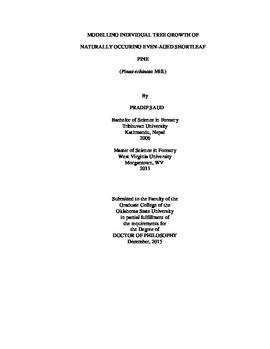| dc.contributor.advisor | Lynch, Thomas B. | |
| dc.contributor.author | Saud, Pradip | |
| dc.date.accessioned | 2018-06-29T14:32:28Z | |
| dc.date.available | 2018-06-29T14:32:28Z | |
| dc.date.issued | 2015-12 | |
| dc.identifier.uri | https://hdl.handle.net/11244/300334 | |
| dc.description.abstract | Modelling individual tree growth is important for the assessment and management of naturally occurring shortleaf pine, as its abundance (hectare) is reducing due to increased plantings of other commercially important southern pine species. Modelling was conducted using six-time measured mensurational data over a period of 25 years from permanent plots in western Arkansas and eastern Oklahoma. The major objectives of this study were to update and modify the existing nonlinear models that use the ordinary least square (OLS) technique to estimate parameters of an individual tree growth model: height-diameter relationship, crown ratio estimation, annual basal area growth, and individual tree mortality. The updated and modified model show that quadratic mean diameter better explained the height-diameter relationship and relative spacing index improved crown ratio estimation of an individual tree. The climate-based model with average minimum air temperature and average total monthly precipitation of the growing season optimized the prediction of annual basal area growth rate by lowering residual standard error by 1% compared to existing growth model. Simulations of climate change scenarios showed that under increased temperature scenarios the annual basal area growth rates of trees are less affected in older stands versus younger stands. The probability of annual mortality of an individual tree was influenced by its size with time (diameter/age), stand level productivity with time (basal area per hectare/age) and stand level competition (quadratic mean diameter). Annual mortality prediction model with a logistic function for binary response performed better than fitting a model with mixedeffects approach. Including a variable of cutting smaller diameter trees - "low thinning effect" - had little impact in the mortality model. OLS estimates of the nonlinear model with and without correction of autocorrelation and of heterogeneous error variance provided better predictions than a mixed-effects model with random effect set to have null effect in prediction. OLS model with the first order autoregressive (AR (1)) structure for modeling auto-correlation within individual observation than within stand in the repeated measurement provided smaller Akaike Information Criteria (AIC). These individual growth models would be very helpful in developing a growth and yield modelling system of shortleaf pine, which could be used to simulate forest growth under different management scenarios. | |
| dc.format | application/pdf | |
| dc.language | en_US | |
| dc.rights | Copyright is held by the author who has granted the Oklahoma State University Library the non-exclusive right to share this material in its institutional repository. Contact Digital Library Services at lib-dls@okstate.edu or 405-744-9161 for the permission policy on the use, reproduction or distribution of this material. | |
| dc.title | Modelling individual tree growth of naturally occurring even-aged shortleaf pine (Pinus echinata Mill.) | |
| dc.contributor.committeeMember | Will, Rodney | |
| dc.contributor.committeeMember | Hallgren, Steve W. | |
| dc.contributor.committeeMember | Habiger, Joshua D. | |
| osu.filename | Saud_okstate_0664D_14462.pdf | |
| osu.accesstype | Open Access | |
| dc.type.genre | Dissertation | |
| dc.type.material | Text | |
| thesis.degree.discipline | Natural Resource Ecology and Management | |
| thesis.degree.grantor | Oklahoma State University | |
